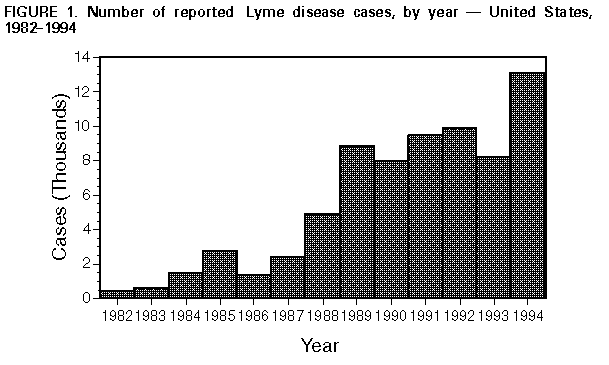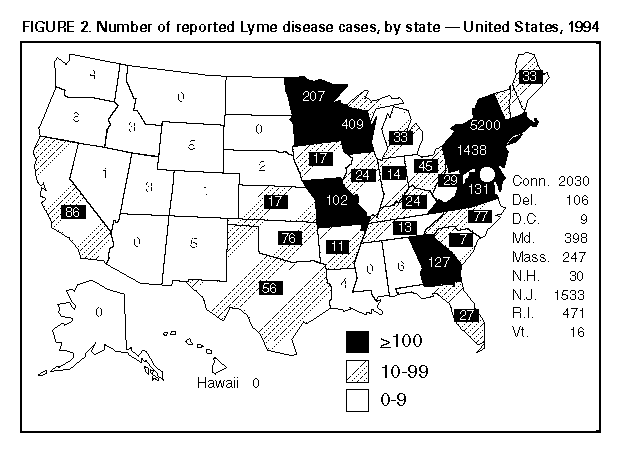 |
|
|
|
|
|
|
| ||||||||||
|
|
|
|
|
|
|
||||
| ||||||||||
|
|
|
|
|
Persons using assistive technology might not be able to fully access information in this file. For assistance, please send e-mail to: mmwrq@cdc.gov. Type 508 Accommodation and the title of the report in the subject line of e-mail. Lyme Disease -- United States, 1994For surveillance purposes, Lyme disease (LD) is defined as the presence of an erythema migrans rash greater than or equal to 5 cm in diameter or laboratory confirmation of infection with Borrelia burgdorferi and at least one objective sign of musculoskeletal, neurologic, or cardiovascular disease (1). In 1982, CDC initiated surveillance for LD, and in 1990, the Council of State and Territorial Epidemiologists adopted a resolution that designated LD a nationally notifiable disease. This report summarizes surveillance data for LD in the United States during 1994. In 1994, 13,083 cases of LD were reported to CDC by 44 state health departments, 4826 (58%) more than the 8257 cases reported in 1993 Figure_1. As in previous years, most cases were reported from the northeastern and north-central regions Figure_2. The overall incidence of reported LD was 5.2 per 100,000 population. Eight states reported incidences of more than 5.2 per 100,000 (Connecticut, 62.2; Rhode Island, 47.2; New York, 29.2; New Jersey, 19.6; Delaware, 15.5; Pennsylvania, 11.9; Wisconsin, 8.4; and Maryland, 8.3); these states accounted for 11,476 (88%) of nationally reported cases. Six states (Alaska, Arizona, Hawaii, Mississippi, Montana, and North Dakota) reported no cases. Reported incidences were greater than or equal to 100 per 100,000 in 15 counties in Connecticut, Maryland, Massachusetts, New Jersey, New York, Pennsylvania, and Wisconsin; the incidence was highest in Nantucket County, Massachusetts (1197.6). Six northeastern states accounted for 95% of the increase in reported cases for 1994: Maryland, New Jersey, New York, Rhode Island, Connecticut, and Pennsylvania. Reported cases increased by 218 cases (121%) in Maryland, 747 cases (95%) in New Jersey, 2382 cases (85%) in New York, 199 cases (73%) in Rhode Island, 680 cases (50%) in Connecticut, and 353 cases (33%) in Pennsylvania. Reported cases remained stable in the states with endemic disease in the north-central region (Minnesota and Wisconsin) and decreased in California (36%). Males and females were nearly equally affected in all age groups except those aged 10-19 years (males: 55%) and those aged 30-39 years (females: 56%). Reported by: State health departments. Bacterial Zoonoses Br, Div of Vector-Borne Infectious Diseases, National Center for Infectious Diseases, CDC. Editorial NoteEditorial Note: LD is the most commonly reported vectorborne infectious disease in the United States. Infection with B. burgdorferi results from exposure to nymphal and adult forms of tick vectors of the genus Ixodes: I. scapularis (black-legged tick) in the northeastern and upper north-central United States, and I. pacificus (western black-legged tick) in the Pacific coastal states. Risk for exposure to B. burgdorferi is strongly associated with the prevalence of tick vectors and the proportion of those ticks that carry B. burgdorferi. The risk for exposure may be highly focal (2) and can differ substantially between adjacent states, counties, communities, and areas on the same residential property (3,4). In northeastern states with endemic disease, the infection rate of nymphal I. scapularis ticks with B. burgdorferi is commonly 20%-35%, and even modest changes in tick numbers can substantially affect the risk for exposure to infected vectors (5). In one area of Connecticut where approximately 15% of I. scapularis are infected with B. burgdorferi, changes in the annual incidence of LD have paralleled changes in I. scapularis densities (M. Cartter, Connecticut Department of Health and Addiction Services, K. Stafford, Connecticut Agricultural Experimental Station, personal communication, 1995). In 1994, tick surveillance in the Northeast indicated increases over previous years in vector tick density. For example, in one site in Westchester County, New York, population density of I. scapularis nymphs increased 400% from 0.4 nymphs per square meter in 1993 to 1.6 nymphs per square meter in 1994 (T. Daniels, Fordham University, R. Falco, Westchester County Department of Health, personal communication, 1995), and in Rhode Island, nymphal I. scapularis density measured at sites throughout the state increased 158% from 1993 to 1994 (T. Mather, University of Rhode Island, personal communication, 1995). Ascertainment of LD cases based only on passive surveillance may result in underreporting of cases (6,7). Because of this and in accordance with recommendations for control of emerging diseases (8), some states in which LD is endemic have expanded surveillance efforts. In 1994, the New York State Department of Health augmented surveillance with additional staff, intensified active case detection, and validated some cases reported in the previous year; these efforts probably accounted for some of the increase in reported cases for New York in 1994 (D. White, New York State Department of Health, personal communication, 1995). Active surveillance, with support from CDC, is conducted by health departments in Connecticut, Michigan, Minnesota, New Jersey, New York, Oregon, Rhode Island, and West Virginia. The risk for infection among persons residing in or visiting areas where LD is endemic can be reduced through avoidance of known tick habitats; other preventive measures include wearing long pants and long-sleeved shirts, tucking pants into socks, applying tick repellents containing N,N-diethyl-m-toluamide ("DEET") to clothing and/or exposed skin according to manufacturer's instructions, checking thoroughly and regularly for ticks, and promptly removing any attached ticks. Acaracides containing permethrin kill ticks on contact and can provide further protection when applied to clothing, but are not approved for use on skin. Additional information about LD is available from state and local health departments, from CDC's Voice Information System, telephone (404) 332-4555; from CDC's Bacterial Zoonoses Branch, Division of Vector-Borne Infectious Diseases, National Center for Infectious Diseases, telephone (970) 221-6453; and from the Office of Communications, National Institute of Allergy and Infectious Diseases, National Institutes of Health, telephone (301) 496-5717. References
Figure_1  Return to top. Figure_2  Return to top. Disclaimer All MMWR HTML versions of articles are electronic conversions from ASCII text into HTML. This conversion may have resulted in character translation or format errors in the HTML version. Users should not rely on this HTML document, but are referred to the electronic PDF version and/or the original MMWR paper copy for the official text, figures, and tables. An original paper copy of this issue can be obtained from the Superintendent of Documents, U.S. Government Printing Office (GPO), Washington, DC 20402-9371; telephone: (202) 512-1800. Contact GPO for current prices. **Questions or messages regarding errors in formatting should be addressed to mmwrq@cdc.gov.Page converted: 09/19/98 |
|||||||||
This page last reviewed 5/2/01
|